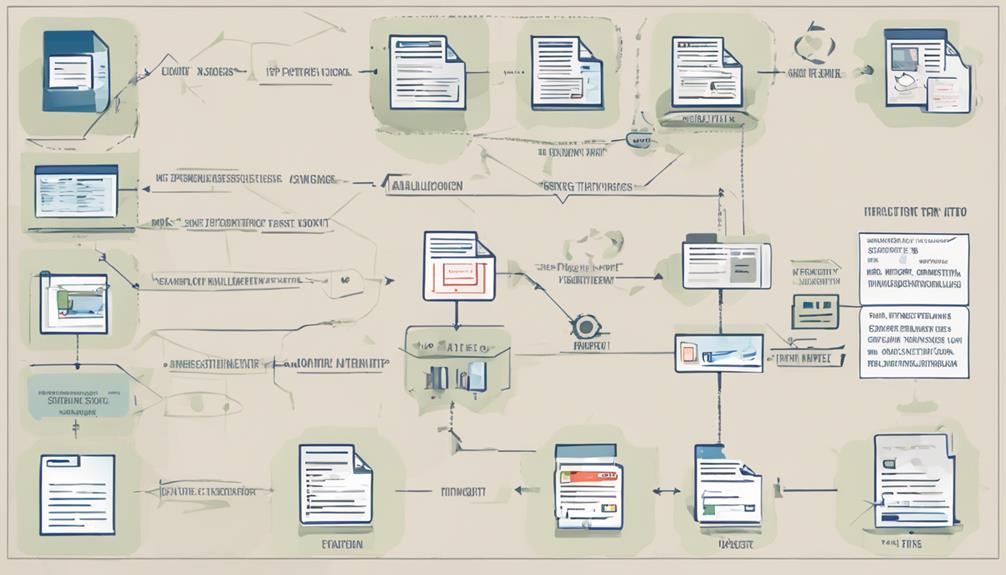When navigating the intricate landscape of SGML conversion, imagine equipping yourself with a set of finely tuned tools designed to streamline your journey towards efficiency. As you embark on this exploration, consider the six effective strategies awaiting your discovery. From selecting the right tools to mastering quality control measures, each strategy holds a key to unlocking enhanced productivity and accuracy in your conversion endeavors. Let’s embark on this journey together and uncover the secrets to improving efficiency in SGML conversion.
Selecting the Right Tools
When embarking on the task of SGML conversion, selecting the right tools is paramount to ensuring efficiency and accuracy throughout the process. Tool evaluation is a critical step in this journey. Begin by assessing your specific needs and requirements for the SGML conversion project. Look for conversion software that aligns with the complexity of your documents and offers features like batch processing, customizable tagging options, and compatibility with your existing systems.
During the tool evaluation process, consider factors such as the software’s user-friendliness, customer support availability, and cost-effectiveness. Opt for conversion software that can handle various SGML structures and formats, enabling a smooth transition without compromising data integrity. By choosing the right tools from the start, you can streamline the conversion process and minimize errors or disruptions along the way.
Streamlining the Conversion Process
To streamline the conversion process, consider implementing automated file handling to efficiently process large volumes of data. Incorporating quality control measures can help ensure accuracy and consistency throughout the conversion. By optimizing these aspects, you can enhance the overall efficiency of your SGML conversion workflow.
Automated File Handling
To enhance the efficiency of SGML conversion, implementing automated file handling is essential. When it comes to streamlining the conversion process, automated file handling can significantly boost productivity and accuracy. Consider the following key points:
- Batch Processing: Automating the conversion of multiple files simultaneously can save time and streamline the overall process. Batch processing allows for efficient handling of a large volume of files without manual intervention.
- Error Handling: Automated file handling systems can be programmed to detect and address errors in real-time, ensuring that the conversion process continues smoothly without interruptions. This proactive approach minimizes the risk of errors in the final SGML output.
- Task Scheduling: By setting up automated task scheduling, you can optimize the conversion process by defining when specific tasks should be executed. This helps in prioritizing tasks and ensuring a steady workflow throughout the conversion project.
Quality Control Measures
For enhancing the efficiency of SGML conversion, implementing robust quality control measures is paramount. Data validation plays a crucial role in ensuring that the converted SGML files are accurate and error-free. By conducting thorough data validation checks, you can identify any inconsistencies or discrepancies in the converted data and rectify them promptly. This step is essential in maintaining the integrity and quality of the SGML conversion process.
Process optimization is another key aspect of quality control measures in SGML conversion. By streamlining and optimizing the conversion process, you can significantly improve efficiency and reduce the likelihood of errors or delays. This can be achieved by automating repetitive tasks, establishing clear workflows, and implementing quality assurance protocols at each stage of the conversion process.
Incorporating these quality control measures not only enhances the accuracy and reliability of the SGML conversion but also contributes to a more streamlined and efficient overall process. By prioritizing data validation and process optimization, you can ensure a successful and error-free SGML conversion.
Training for Conversion Efficiency
To enhance conversion efficiency, consider incorporating skill-building workshops and continuous learning programs for your team. These initiatives can help your staff stay updated on the latest SGML conversion techniques and tools, ultimately improving their proficiency in handling complex conversion tasks. By investing in training programs, you can empower your employees to work more efficiently and accurately, leading to smoother SGML conversion processes.
Skill-Building Workshops
Participating in skill-building workshops is essential for enhancing efficiency in SGML conversion. These workshops provide hands-on practice and foster collaborative learning, which are crucial for mastering the intricacies of SGML. Here are three key benefits of skill-building workshops:
- Interactive Sessions: Engage in interactive sessions where you can apply SGML conversion techniques in real-time, allowing you to grasp concepts effectively.
- Peer Feedback: Receive valuable feedback from peers and instructors, enhancing your understanding and refining your conversion skills.
- Practical Exercises: Engage in practical exercises that simulate real SGML conversion scenarios, preparing you to tackle challenges efficiently in your actual work environment.
Skill-building workshops offer a dynamic learning environment where you can enhance your SGML conversion skills through practical experience and collaborative interactions. By actively participating in these workshops, you can boost your efficiency in SGML conversion and stay ahead in the ever-evolving landscape of data conversion.
Continuous Learning Programs
How can you continuously enhance your skills in SGML conversion for optimal efficiency? Continuous Learning Programs play a crucial role in improving employee engagement and performance metrics. By participating in ongoing training sessions, you can stay updated on the latest SGML conversion techniques, tools, and best practices. These programs provide you with the opportunity to sharpen your existing skills and acquire new ones, ultimately leading to higher productivity and accuracy in your conversion tasks.
Engaging in Continuous Learning Programs also fosters a culture of continuous improvement within your team. By sharing knowledge and experiences with colleagues, you can collectively enhance your SGML conversion capabilities and address any challenges more effectively. Additionally, these programs enable you to align your performance metrics with industry standards, ensuring that your conversion processes meet or exceed expectations.
To maximize the benefits of Continuous Learning Programs, actively participate in workshops, webinars, and online courses that focus on advanced SGML conversion techniques. By investing in your ongoing development, you can become a more proficient and efficient SGML converter, contributing to overall organizational success.
Outsourcing for Efficiency
Optimizing efficiency in SGML conversion can often involve considering outsourcing as a strategic solution. When contemplating outsourcing as a part of your efficiency improvement plan, there are a few key factors to keep in mind:
- Vendor Management: Effectively managing the relationship with your outsourcing partner is crucial for success. Clear communication, setting expectations, and regular check-ins are essential for a smooth process.
- Cost Analysis: Conducting a thorough cost analysis is necessary to ensure that outsourcing is financially viable. Consider not only the initial costs but also long-term savings and potential return on investment.
- Quality Assurance: Implement robust quality control measures to maintain the standard of work expected from an outsourced partner. Regular audits, feedback mechanisms, and performance evaluations can help uphold quality standards.
Outsourcing can streamline your SGML conversion process, but it requires careful planning and oversight to reap the benefits effectively.
Quality Control Measures
Implementing effective quality control measures is essential in maintaining the standards of work during SGML conversion. To ensure accuracy and consistency, incorporate robust error detection mechanisms throughout the conversion process. Utilize automated tools to identify discrepancies in the SGML files, allowing for swift corrections and preventing errors from propagating further down the line. Regularly conducting thorough quality checks at key stages of the conversion will help in identifying and rectifying any issues promptly.
Furthermore, implementing a process improvement approach is crucial for enhancing the overall quality of SGML conversion. Analyze the root causes of errors identified during quality control checks to pinpoint recurring issues and implement preventive measures. By continuously refining the conversion process based on these insights, you can minimize errors, streamline workflows, and boost efficiency. Emphasizing a culture of continuous improvement will drive ongoing enhancements in the quality of SGML conversion outputs.
Managing Costs Efficiently
To effectively manage costs during SGML conversion, it is crucial to conduct a comprehensive analysis of the project budget and resource allocation. Cost management and resource optimization are key factors in ensuring the efficiency of the conversion process. Here are some strategies to help you manage costs efficiently:
- Prioritize Tasks: Identify critical tasks and allocate resources accordingly to focus on high-impact areas first.
- Evaluate Tools and Technologies: Invest in tools that streamline the conversion process and maximize resource utilization.
- Monitor Progress Continuously: Regularly track project expenses and resource usage to identify any deviations from the budget and make necessary adjustments promptly.
Frequently Asked Questions
How Can I Ensure Data Security During SGML Conversion?
To ensure data security during SGML conversion, implement robust data encryption and access control measures. Encrypt sensitive information to protect it from unauthorized access. Utilize access controls to restrict who can view or modify the data, enhancing overall security.
What Are the Best Practices for Handling Legacy Documents?
When handling legacy documents, ensure thorough document analysis to understand content structure. Extract metadata efficiently for accurate conversion. These practices streamline the process and maintain data integrity. Embrace them to enhance efficiency in your SGML conversion project.
Is It Possible to Automate the Quality Control Process?
Yes, you can automate the quality control process. Automated validation tools streamline quality assurance, ensuring accuracy and efficiency. Implementing these tools enhances SGML conversion by reducing manual checks and errors, ultimately saving time and improving overall productivity.
How Can I Maintain Consistency Across Large Conversion Projects?
To maintain consistency across large conversion projects, ensure version control by tracking changes. Implement quality assurance checks to validate accuracy. Utilize automated tools for efficiency. Regularly review and update guidelines to align with project requirements and standards.
What Are the Common Challenges Faced During SGML Conversion Projects?
During SGML conversions, challenges like time management and resource allocation can hinder format preservation and content accuracy. Stay organized, allocate resources wisely, and prioritize tasks to overcome these obstacles efficiently and ensure project success.



